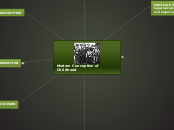jonka Gillian Dickinson 10 vuotta sitten
731
Modern Conception of Childhood
This mind map relates to the compulsory question in Section A of the exam paper, 2014-15

jonka Gillian Dickinson 10 vuotta sitten
731

Lisää tämän kaltaisia
The question covers a number of central concerns. These are:
This map relates to the compulsary Section A of the exam, specifically question 1. It aims to outline modern conceptions of 'childhood' and ‘juvenile delinquency’ in regards to the exploration of the discovery of ‘adolescence’ as a separate age of man and the determination as to whether both concepts are a historical or social construction.
It is both these aspects, the historical and social construction of childhood that form the backdrop of the question, more importantly the institutional framing of 'youth' and the social responses to it.
Regulation
The extension of the period of childhood dependency through a number of legislative and institutional changes
It was against this very backdrop that a construction of youth and adolescent rather than childhood; and a reconstruction of juvenile delinquent were to take place.
Criminalisation
the development of more sophisticated surveillance techniques such as philanthropic schooling and policing, made children more problematic and visible.
As in contemporary society, the complex insecurities of the era came to bear upon the young, but this time on ‘youth’, opposed to ‘childhood’.
Both are concerned with the practical threat of the unregulated child to the preservation of the social order.
Both view social and physical regulation as vital to both the moral well being of the child and the moral well being of society.
Both focus on the special nature of the child,
Marks a watershed in the transition to education and schooling for the masses.
For the first time, ‘juvenile delinquency’ had been recognised legislatively, ‘as a distinct social phenomenon’.
Hand in hand, the Schooled child and the Delinquent child began to form.
Cited as the cut-off point of these social developments. Enforcement of the act prevented the employment of children under 9 and limited working hours for those aged between 9 and 13.
The children of the working classes were seen as the biggest social threat.
The notion of the Romantic child and all it stood for was seen as being under siege from the brutalization of children in the work place.
Differing versions of childhood are identified as being reflective of the social conditions of the time rather than as natural or intrinsic qualities of a universal state of childhood.
The Romantic child, the Evangelical child, the Factory child the Delinquent child and the Schooled child.
In Aries view, it is only since this time that we have become preoccupied with the social moral and sexual development of young people.
For most of the eighteenth century (1700s) there was no concept of childhood in any recognizable modern sense. In other words, children tended to be expected to pass straight from physical dependence to something close to adulthood. The period of physical dependence was taken to last up to about age 7-10. After that most children were expected to work adult hours ... and if convicted of a crime were held fully responsible and punished as adults. In Britain and France the 1770s saw the gradual rise of the concept of an intermediate stage between physical dependence (infancy) and adulthood, namely childhood. The first books written specifically for children and some children's clothing began to appear for the first time. This development was largely confined to the middle classes, and for the poor it had to wait until well after 1850. The concept of adolescence - that is, a period between childhood and adulthood - is even more recent. I've deliberately avoided mentioning the Enlightenment, as the beginnings
Typically attributed to the work of Philippe Aries and his work, Centuries of Childhood (1973). He was of the view that the notion of ‘childhood’ as we know it contemporarily, was absent in medieval societies.